The history of Internet and how it became a worldwide “thing”
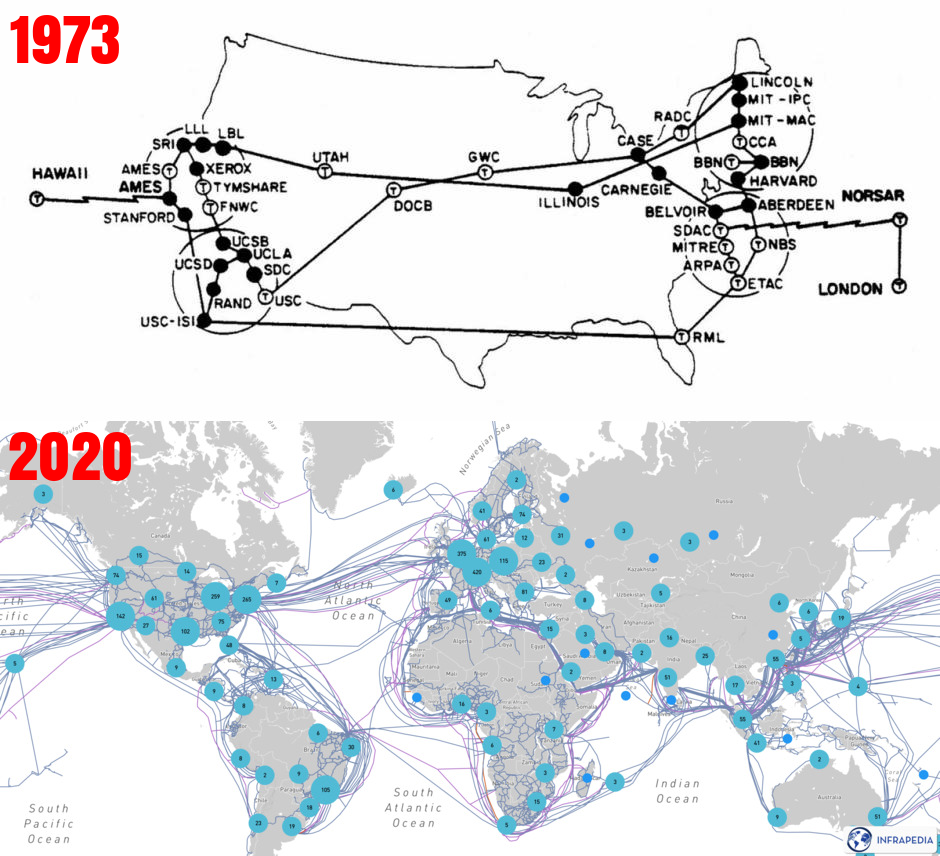
Reading Time: 10 Minutes
Interconnected Computers and how it got started
Upon clicking on this article’s page, your computer sends a message to a server that might be countries or even continents away.
The message told the server to search for a file and then send it back to your device, personal computer, etc., piece by piece in the form of ones and zeros until the whole page is loaded.
How we ended up in a world where billions of devices and computers are interconnected?
Through the power of the Internet.
Computers begin to “talk” to each other since WW2, in 1941 where big machines were used to solve math problems.
The computers on that day and even today’s computers will take a very long time to complete physics and math problems involving the making of the atomic bomb.
In the US, Richard Feynman, a physicist, and his team found a way to solve more problems at once.
Due to the difficult nature of the problems he wanted to solve, and the time needed, Feynman found a solution by using computers that weren’t being used for a part of one problem, and use them on a part of a different problem, reducing the time that the problems needed to be solved significantly.

Richard Feynman
Developments in 1950 and 60s
Universities at that time started using their computer terminals separated, meaning someone could type their program form the computers themselves, and made it easy and accessible to different people to experiment.
This can be described as an early cloud computing system without the use of the internet where a user-friendly computer could use the resources of a better, less accessible computers.
Cold War developments and ARPA
During the cold war, the US wanted something more advanced to keep up the competition with the Soviets and created Advanced Research Projects Agency (ARPA).
At that time military experts and scientists were concerned about what could happen in the event of a Soviet attack on the nations’ telephone systems making long-distance communication impossible.
In 1962, MIT computer scientist J.C.R. Licklider comes up with the idea for a global computer network. , such a network would enable government leaders to communicate even if the Soviets destroyed the telephone system.
ARPA then decided to fund research for computer network connecting scientists and engineers throughout the country.
Several colleges were involved in the project, along with UCLA, UC Santa Barbara, Stanford, University of Utah.
Packet Switching
In the early 1960s, an American computer scientist Paul Baran developed a way of sending information from one computer to another that he called “packet switching.”
Packet switching breaks data down into blocks, or packets, before sending it to its destination.
That way, each packet can take its route from place to place.
Without packet switching, the government’s computer network, now known as the ARPANET, would have been just as vulnerable to enemy attacks as the phone system.
ARPANET
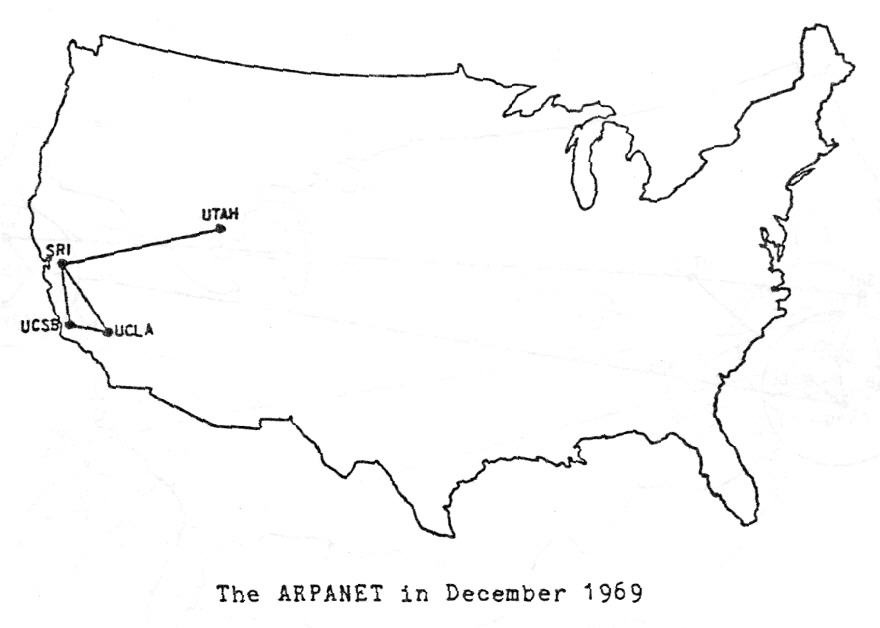
1969 ARPANET
ARPA started building the network in 1969 and called it ARPANET, the Advanced Research Projects Agency Network.
On October 29, 1969, ARPANET delivered its first message: a “node-to-node” communication from one computer to another, using a computer located in a research lab at UCLA and the second was at Stanford.
The message “LOGIN” was short and simple, but it crashed the ARPA network anyway, and the Stanford computer only received the note’s first two letters “LO”.
Then, ARPANET started fairly small, as a sort of messaging service between the universities involved.
Circuit switching, that was the technology the telephone system was using at that time was inefficient to work with the new project involving computers, due to the simple reason that circuit switching was only able to make a connection at a time(using one wire only) and took a long time to connect to another computer, making it impractical.
ARPANET used packet switching from the start, and its packets traveled over phone lines.
Packet switching that was developed by Baran, was one of the first big innovations that were incorporated to ARPANET, making it possible for different computers to send messages along with the same set of wires instead of each getting one like the circuit switching.
Computers, to communicate with each other they must send a message, called a packet along the wires.
The packet had an address, a string of numbers representing the computer where it was headed, the computer where it started would look up the address on a table with all the addresses in the network, and send the packet to whatever nearby computer was the closest.
The second computer that would get the packet, would look up to the destination address and again send the packet in the right direction, repeating the same process over and over until the packet finally goes to its destination through the phone lines.

ARPANET Geographic Map, September 1973.
The next couple of years ARPANET’s packet-switching was facing problems, due to the growing number of computers around the country that joined the network.
The way that packet switching system was set up, meant that every computer must always keep an updated list of all the other computer addresses that were connected because otherwise, the computers wouldn’t know where to send packets to or sent them to a disconnected computer.
In 1971, it added the University of Hawaii’s ALOHAnet, and two years later it added networks at London’s University College and the Royal Radar Establishment in Norway.
ARPANET changed their systems that the computers addresses and selected Stanford as the official record-keeper of the computer addresses in 1973.
They did this to avoid the problems that arose when the network grows in size and sometimes the computer’s address might have changed if it was temporarily disconnected from the network, thus ending up with different computers with different address books because they didn’t get updated fast.
Internet’s first computers
The network kept growing throughout the seventies with sixty computers in 1974 and over a hundred by the late 1970s.
During the 1970s different networks were already existing at the time, and some of them had even more computers than ARPANET.
Every network formatted their packets differently so it was very difficult even though possible, to connect different networks.
By the end of the 1970s, two computer scientists named Vinton Cerf and Robert Kahn had begun to solve this problem by developing a way for all of the computers on all of the world’s mini-networks to communicate with one another. He called his invention “Transmission Control Protocol,” or TCP, which is still in use today.
The TCP was a standard way of formatting packets to make possible communication between the networks and computers.
The Internet Protocol or IP was the standard way of assigning addresses to eliminate the confusion about where the packets were headed.
So, all the different networks were connected using TCP/IP and form what we knew as the Internet with the ARPANET as the base of it.
Also in the 1970s, Robert Metcalfe, an American engineer developed a system using cables that allows for the transfer of more data over a network.
He named this system Alto Aloha, known as of today as Ethernet.
Over the next few years, Ted Nelson, American pioneer of information technology, proposes using hypertext to organize network information, and Unix becomes popular for TCP/IP networks.
Tom Truscott and Steve Bellovin, American computer engineers develop a Unix-based system for transferring data over phone lines via a dial-up connection.

TCP/IP and Internet Inventors Vinton Cerf and Robert Kahn
Again, the network finds it difficult to keep up with growing numbers of computers, the record-keepers at Stanford were getting overloaded because new and existing computers were joining and changing addresses and then trying to download the updated address book which occasionally had errors and cause problems to the whole network.
One of the main problems was email. The email was invented in 1971 and by 1973, ARPANET’s packets were overwhelmingly filled with emails.
Different computers that had different email software, or some required a list of every node (computer) that the message would be passed between the sender and receiver, so everyone had an updated map with the entire network and then type out the path of their email to send it.
Engineers realized that because of the large number of computers on ARPANET and the Internet in general, those maps would get impossible to keep and maintain.
Domain Name System is born
In 1983, after some years to deal with this problem a group including Jon Postel, Paul Mockapetris, and Craig Partridge published RFC 882 which created the domain name system (DNS) to make Internet navigation easier.
The hosts were arranged into domains instead of separating them and storing their addresses in random order.
Top-level domains like .com, .edu, .org. where the first to come. Then, within these top-level domains, second-level domains were each host on the top-level domain like example.com or example.edu.
This domain structure organized all the different hosts worldwide and then, DNS added a new network to the Internet whose job was to track addresses and connections.
Several new computers on the network mapped out the entire network and store all the top-level domains making it easy to send emails back then where you didn’t have to check and map the connections yourself to send it like before the DNS which it became and it still is its job today.
The end of ARPANET and the beginning of the Internet
In the 1980s the Department of Defense, the founders of ARPANET decided to end the project since their target was completed as they wanted a reliable network of interconnected computers but ended up serving the base of a global network around the world, involving thousands of universities, companies, and governments.
Since the Department of Defense decided not to fund ARPANET anymore, they hand off the responsibility for maintaining the Internet to some other network and move on.
NSFNET
In 1986, the National Science Foundation’s network-NSFNET was big enough as a network to be the next candidate, and since it’s connection to ARPANET grow exponentially and by the next year, it already needed upgrades for the new computers on the network.
By the end of 1987, the Internet had over 20 thousand computers on its network.
It was restricted to universities and specific corporations that were using it for collaboration and research.
Even before ARPANET, some private companies had networks where they were connecting regular people to the Internet.
In 1987, NSFNET had already established a policy about banning commercial traffic on the network but they decided to connect some private network email servers to NSFNET in 1988.
In 1988, some users of CompuServe (the first online service to offer Internet connectivity to users) and MCI mail, an email service, could send the first commercial emails using the Internet. In 1989, the first Internet Service Providers-ISPs began to rise.
Many private companies opened and connected people to a local network and then to the Internet because they didn’t have a network on their own.
After almost 3 years, in 1990, NSFNET replaced ARPANET as the base of the internet with at that time, more than 500 thousand users worldwide.

T1 NSFNET Backbone, c. 1991
Congress passed a law in 1992 allowing commercial traffic on NSFNET.
Congress passed its Scientific and Advanced-Technology Act of 1992 that formally permitted NSF to connect to commercial networks in support of research and education.
Mosaic, the first freely available Web browser to allow Web pages to include both graphics and text, which was developed in 1993 by students and staff working at the NSF-supported National Center for Supercomputing Applications (NCSA) at the University of Illinois.
For the next couple of years, many ISP’s opened.
Some of them providing just email, some offered internet access without an online community of their own and they were partly connected to the Internet.
NFSNET closes and gives the network to ISP’s
By 1995, NFSNET shut down and everything was handed to the ISP’s.
Dial-up
For a computer to connect to the Internet, it should have placed a phone call to the network through a modem that was translating between the digital signals in the computer and the analog signals used in the landline phones.
At the time since phone lines already cross the US when ARPANET was invented and it was more convenient to use them instead of trying to create a new system.
The computer then would communicate with other devices on the network through the phone network between them.
This is known as dial-up, it was slow, around 40–50 kbit/s download, to put it in perspective, the time to download a 2GB file with that speed would be around 90 hours.
At the time it didn’t seem slow because the internet was already a newborn for commercial use, with no big files, no billions of users like in 2020.
The dial-up was extremely slow because it’d got a limit on how quickly it can pack information down a phone line. To transmit a lot of information, you need a signal with high frequency, which can change quickly, and for a signal sent down the phone line, it would mean a high-pitched sound where phones weren’t designed for that but to make phone calls.
Internet vs. Web
Many people confusing the terms Web and Internet to be the same but the internet came more than 10 years before the web.
Internet is a shortened form of the word “internetworking”, it was created in the 1970s and referred to as the physical cables and computers all connecting.
The Internet is a global network of networks while the Web, also referred formally as World Wide Web (www) is a collection of information that is accessed via the Internet. The internet began with network designs as a way to remotely share programs., files, and access to remote computers.
Before the Web, as the Internet was growing bigger and bigger, it became difficult to navigate where you want to go, even in smaller Networks like the CERN’s.
There was different information on different computers, but a user had to log on to different computers to get at them, and often sometimes a user needed to learn a different program on each computer to access the information.
In 1989, Tim Berners-Lee, a scientist at CERN, invented the World Wide Web, known as WWW, as a way to arrange all that information he was having difficulties to find.
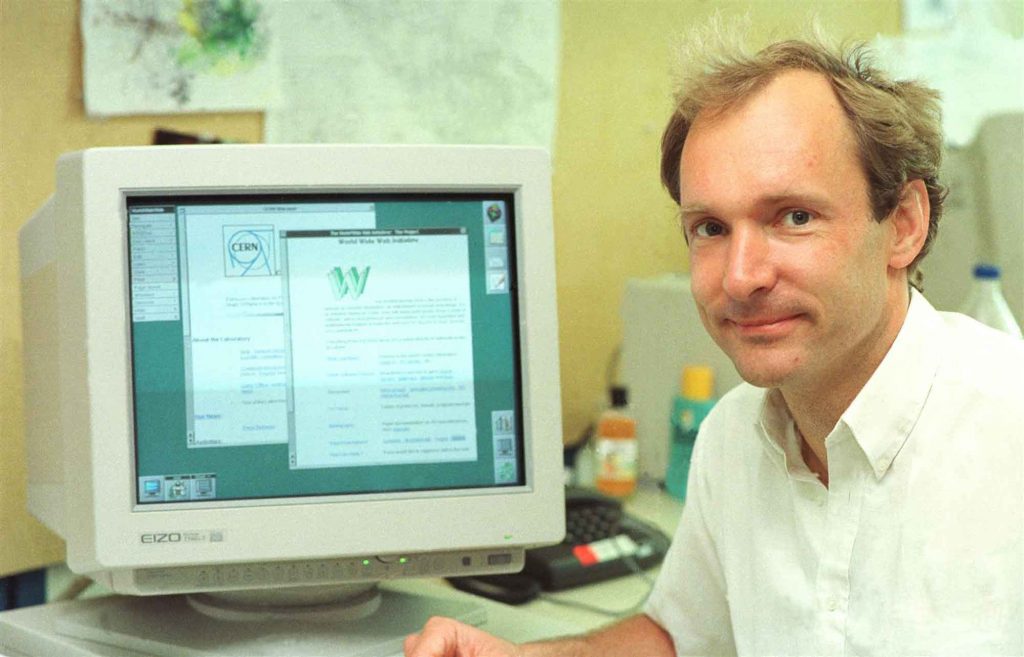
Tim Berners-Lee
The web was originally conceived and developed to meet the demand for automatic information-sharing between scientists in universities and institutes around the world.
The basic idea of the WWW was to merge the technologies of personal computers, computer networking, and hypertext into a powerful and easy to use the global information system.
Instead of each file being like its own isolated branch(like before the Web), any documents or files could direct people to other related files using the technologies, Tim Berners-Lee invented.
By October of 1990, Tim had written the three fundamental technologies that remain the foundation of today’s web (and which you may have seen appear on parts of your web browser):
· HTML: HyperText Markup Language. The markup (formatting) language for the web.
· URI: Uniform Resource Identifier. A kind of “address” is unique and used to identify each resource on the web. It is also commonly called a URL.
· HTTP: Hypertext Transfer Protocol. The set of programs that allows for the retrieval of hyper-linked resources from across the web.
Hypertext is a text which contains links to other texts. The term was invented by Ted Nelson around 1965.
Tim Berners-Lee’s invention of HTML made the hypertext concept the primary way of navigating through the World Wide Web with hyperlinks connecting a user to different web-pages, files, etc.
For example the following link: https://www.example.com is constructed by:
- · The HTTPS is the protocol, which is an HTTP that uses SSL to encrypt HTTP requests and responses.
- · :// is a way of introducing what comes next in the URL.
- · www indicates that this page is a part of the world wide web.
- · Example.com is the domain name
Dot-com bubble:
In the 1990s, a lot of investors invest their money into internet companies without even knowing if they are going to make a profit or get a lot of customers.
Just because the Internet was something new for the public a lot of startups invested without worrying about it, they thought that they only needed a good idea and enough money to succeed in this new digital world.
In 1994, one of the first social networking sites, GeoCities founded.
At the time, most of the websites divided their traffic into users and creators. Creators wrote the code and assembled the hyperlinks pictures etc., and the users would just visit the webpages that the creators made.
GeoCities though, mixed users and creators together, meaning everyone with an account could do both.
They developed a different model that anyone could make a GeoCities account and create their website (formatting, backgrounds, interests).
The users could send messages to each other, and join communities with similar topics and interests.
In 1999, GeoCities became the 3rd most popular site on the Web, behind AOL and Yahoo!.
When Yahoo! bought GeoCities for $3.7 billion in 1999, CNN Money called it a move that would “solidify Yahoo!’s position as a front-runner in the online popularity contest.” History shows us otherwise.
In March of 2000, this bubble explode and stock in tech companies plummeted for the next year or so, and over half of them declared bankruptcy, losing trillions of dollars in the process.
2015, the year that Nasdaq Composite Index hit the 5,000 mark for the first time since March 2000.
After the bubble
This disastrous fall by many companies back then may pave the way for more stable and well-run companies to thrive in the Web.
After the bubble, GeoCities never managed to regain its former glory though, and
Yahoo terminates it back in 2009 when it had long since been surpassed by other sites that took the idea of social networking and innovate it like Facebook, Hi5, MySpace, etc.
A lot of social networking companies have been created or recognized over the last decade or so, Reddit, Twitter, Tumblr, LinkedIn, YouTube are few of the many that have online communities, comment sections, blogs all over the web.
All these sites are descended from the first site to mix users and creators in a new way of using the Internet, and that was GeoCities.
Broadband connections From the start of 2000, internet users started connecting to the Internet via a much higher speed connection. Broadband connections after 2005, became the most popular way to get users online, as technology advanced more, the broadband connection became cheaper and available, thus most of the dial-up users switched over to broadband. Using Dial-up, each time a user’s PC dials into the ISP, it is assigned an IP address, which anyone can think of as an “Internet address.” A different, unique IP address is assigned at the beginning of each visit so that the ISP can recognize the computer and make sure that it can send and receive the email, surf the Internet, and so on. This address lets the ISP know where to send the information that a user request’s through the modem. Broadband connections can be defined all the ways of getting online that aren’t dial-up, in contrast to dial-up, when a computer connects to the Internet via a broadband Internet connection, the process is different. Once the computer is connected to the ISP through a cable or DSL connection, it remains connected until the cable box or DSL line is disconnected or physically unplugged. Depending on the type of broadband connection, the connection can be 100 or 1000s of times faster than the old dial-up connection.
Data explosion 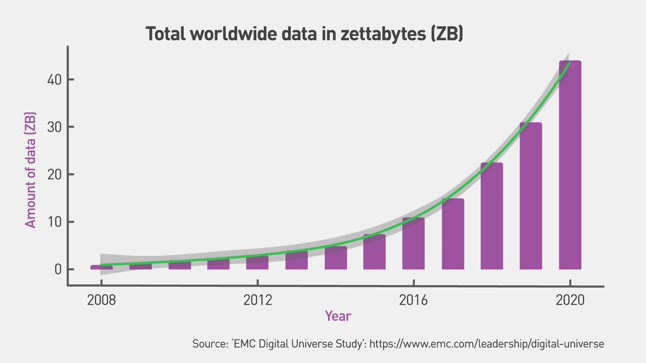
Data explosion - EMC Digital Universe Study
As users and creators handed a greater Internet speed, site creators could add multiple pictures or even videos on their websites.
The problem then was the storage, all the data needed to be stored somewhere. That’s when Data Centers came to place to solve the problem of storage and give the best user experience when visiting a website.
The data centers are rooms or even buildings with several computers that can host a lot of data for companies or even website owners.
They were popular in the 80s when a lot of companies were renting data centers for their needs, but as the dot-com bubble was inflating this model became popular.
Data centers were the perfect place for companies that needed storage for their data and computer speed to handle their traffic on their websites because instead of owning/maintaining their computers they could easily rent a place inside a data center.
Today’s Web and Internet
From 5 computers in the 1970s, to billions in 2020, the Internet, and the WEB evolves every day passing.
The model where the data centers were working after the 2000s continues to serve most of the websites and companies of today’s world.
Websites of today have on average 150 times as much data on them as they did in the late ’90s.
UN declared Internet access as a Human Right in 2011 showing that the Internet is built for the worldwide community and everybody has the same right to access the information available on the Internet.
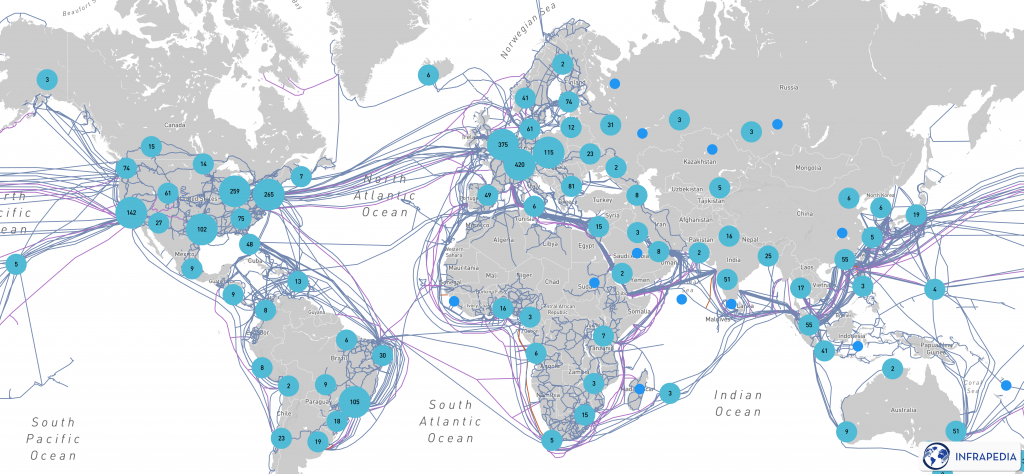
Global Internet backbone map, Infrapedia Map September 2020
Today’s Web relies on huge collections of computers to working together.
Computers nowadays they don’t just store all the web site’s data, they run special programs/algorithms through those data and use the information they saved about the individual user to decide what you maybe want to see next. (personalized ads, video recommendations, posts, etc.).
This can be helpful and useful in a general manner but it can also be a technique to manipulate users by showing they targeted ads, posts, videos that companies want to promote, affecting them negatively in ways that they don’t even notice it.
Every day passes and there’s another news story about governments or companies that track user’s data or even sold them to a third party.
The way a user chooses to use the Internet and Web is not written anywhere, but all users should know where it all started from, and beware of the dangers that lie to the digital world.
To be able to use the Internet is a privilege for every human, so anyone should use it for their benefit and also for the people in their community and for a better world where information and knowledge can be accessed/exchanged on the blink of an eye.
References
- https://marketrealist.com/2015/03/nasdaq-5000-dot-com-bubble/
- https://www.wikiwand.com/en/National_Science_Foundation_Network
- https://laptrinhx.com/who-invented-the-internet-3300946378/
- https://home.cern/science/computing/where-web-was-born
- https://webfoundation.org/about/vision/history-of-the-web/
- https://www.diplomacy.edu/blog/%E2%80%98un-declares-internet-access-human-right%E2%80%99-%E2%80%93-did-it-really
- https://en.wikipedia.org/wiki/Paul_Baran
- https://www.computerhistory.org/timeline/1944/
- https://www.history.com/topics/inventions/invention-of-the-internet
- https://live.infrapedia.com/










